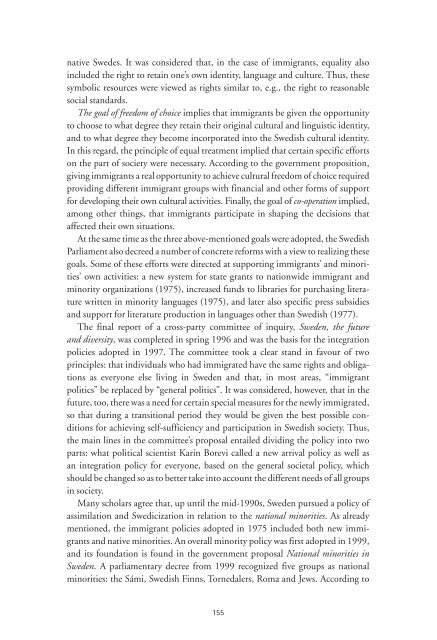Minoritetsmedier och minoritetsmediepolitik i Sverige - Myndigheten ...
Minoritetsmedier och minoritetsmediepolitik i Sverige - Myndigheten ...
Minoritetsmedier och minoritetsmediepolitik i Sverige - Myndigheten ...
You also want an ePaper? Increase the reach of your titles
YUMPU automatically turns print PDFs into web optimized ePapers that Google loves.
native Swedes. It was considered that, in the case of immigrants, equality also<br />
included the right to retain one’s own identity, language and culture. Thus, these<br />
symbolic resources were viewed as rights similar to, e.g., the right to reasonable<br />
social standards.<br />
The goal of freedom of choice implies that immigrants be given the opportunity<br />
to choose to what degree they retain their original cultural and linguistic identity,<br />
and to what degree they become incorporated into the Swedish cultural identity.<br />
In this regard, the principle of equal treatment implied that certain specific efforts<br />
on the part of society were necessary. According to the government proposition,<br />
giving immigrants a real opportunity to achieve cultural freedom of choice required<br />
providing different immigrant groups with financial and other forms of support<br />
for developing their own cultural activities. Finally, the goal of co-operation implied,<br />
among other things, that immigrants participate in shaping the decisions that<br />
affected their own situations.<br />
At the same time as the three above-mentioned goals were adopted, the Swedish<br />
Parliament also decreed a number of concrete reforms with a view to realizing these<br />
goals. Some of these efforts were directed at supporting immigrants’ and minorities’<br />
own activities: a new system for state grants to nationwide immigrant and<br />
minority organizations (1975), increased funds to libraries for purchasing literature<br />
written in minority languages (1975), and later also specific press subsidies<br />
and support for literature production in languages other than Swedish (1977).<br />
The final report of a cross-party committee of inquiry, Sweden, the future<br />
and diversity, was completed in spring 1996 and was the basis for the integration<br />
policies adopted in 1997. The committee took a clear stand in favour of two<br />
principles: that individuals who had immigrated have the same rights and obligations<br />
as everyone else living in Sweden and that, in most areas, “immigrant<br />
politics” be replaced by “general politics”. It was considered, however, that in the<br />
future, too, there was a need for certain special measures for the newly immigrated,<br />
so that during a transitional period they would be given the best possible conditions<br />
for achieving self-sufficiency and participation in Swedish society. Thus,<br />
the main lines in the committee’s proposal entailed dividing the policy into two<br />
parts: what political scientist Karin Borevi called a new arrival policy as well as<br />
an integration policy for everyone, based on the general societal policy, which<br />
should be changed so as to better take into account the different needs of all groups<br />
in society.<br />
Many scholars agree that, up until the mid-1990s, Sweden pursued a policy of<br />
assimilation and Swedicization in relation to the national minorities. As already<br />
mentioned, the immigrant policies adopted in 1975 included both new immigrants<br />
and native minorities. An overall minority policy was first adopted in 1999,<br />
and its foundation is found in the government proposal National minorities in<br />
Sweden. A parliamentary decree from 1999 recognized five groups as national<br />
minorities: the Sámi, Swedish Finns, Tornedalers, Roma and Jews. According to<br />
155

















